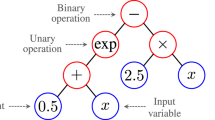Abstract
The purpose of this paper is to present a method for solving nonlinear time-dependent drainage model. This method is based on the perturbation theory and Laplace transformation. The proposed technique allows us to obtain an approximate solution in a series form. The computed results are in good agreement with the results of Adomian decomposition method. Results are presented graphically and in tabulated forms to study the efficiency and accuracy of method. The present approach provides a reliable technique, which avoids the tedious work needed by classical techniques and existing numerical methods. The nonlinear time-dependent drainage model is solved without linearizing or discretizing the nonlinear terms of the equation. The method does not require physically unrealistic assumptions, linearization or discretization in order to find the solutions of the given problems.


Similar content being viewed by others
References
Weaire D, Hutzler S (2000) The physic of foams. Oxford University Press, Oxford
Weaire D, Hutzler S, Cox S, Alonso MD, Drenckhan D (2003) The fluid dynamics of foams. J Phys Condens Matter 15:65–72
Helal MA, Mehanna MS (2007) The tanh method and Adomian decomposition method for solving the foam drainage equation. Appl Math Comput 190:599–609
Hilgenfeldt S, Koehler SA, Stone HA (2001) Dynamics of coarsening foams: accelerated and self-limiting drainage. Phys Rev Lett 86:4704–4707
Verbist G, Weaire D, Kraynik AM (1996) The foam drainage equation. J Phys Condens Matter 83:715–3731
Koehler SA, Stone HA, Brenner MP, Eggers J (1998) Dynamics of foam drainage. Phys Rev E 58:2097–2106
Dahmani Z, Mesmoudi MM, Bebbouchi R (2008) The foam drainage equation with time- and space-fractional derivatives solved by the Adomian method. Electron J Qual Theory Differ Equ 30:1–10
Mirmoradi SH, Hosseinpour I, Barari A, Ghotbi AR (2009) Analysis of foam drainage problem using variational iteration method. Adv Stud Theor Phys 3:283–292
Dahmani Z, Anber A (2010) The variational iteration method for solving the fractional foam drainage equation. Int J Nonlinear Sci 10:39–45
Fadravi HH, Nik HS, Buzhabadi R (2011) Homotopy analysis method for solving foam drainage equation with space- and time-fractional derivatives. Int J Differ Equ 2011:12, Art ID 237045
Khan Y, Wu Q (2011) Homotopy perturbation transform method for nonlinear equations using He’s polynomials. Comput Math Appl 61:1963–1967
Khan Y, Mohyud-Din ST (2010) Coupling of He’s polynomials and Laplace transformation for MHD viscous flow over a stretching sheet. Int J Nonlinear Sci Num Simul 11:1103–1107
He JH (2000) A coupling method of a homotopy technique and a perturbation technique for non-linear problems. Int J Nonlinear Mech 35:37–43
Abbasbandy S (2006) Application of He’s homotopy perturbation method for Laplace transform. Chaos Solitons Fractals 30:1206–1212
Mohyud-Din ST, Noor MA, Noor KI, Hosseini MM (2010) On the coupling of He’s polynomials and Laplace transformation. Int J Nonlinear Sci Num Simul 11:93–96
Madani M, Fathizadeh M, Khan Y, Yildirim A (2011) On the coupling of the homotopy perturbation method and Laplace transformation. Math Comput Model 53:1937–1945
Khan Y, Wu Q, Faraz N, Yildirim A (2011) The effects of variable viscosity and thermal conductivity on a thin film flow over a shrinking/stretching sheet. Comput Math Appl 61:3391–3399
Khan Y, Faraz N, Yildirim A, Wu Q (2011) A series solution of the long porous slider. Tribol Trans 54:187–191
He JH (2011) Analytical methods for thermal science-an elementary introduction. Therm Sci 15:S1–S3
Hesameddini E, Latifzadeh H (2009) Reconstruction of variational iteration algorithm using the Laplace transform. Int J Nonlinear Sci Num Simul 10:1377–1382
Turkyilmazoglu M (2011) An optimal variational iteration method. Appl Math Lett 24:762–765
Mohyud-Din ST, Yildirim A (2010) Variation of parameters method using Laplace transformation method. World Appl Sci J 9:300–302
Khan Y (2009) An effective modification of the Laplace decomposition method for nonlinear equations. Int J Nonlinear Sci Num Simul 10:1373–1376
Khan M, Gondal MA (2010) A new analytical solution of foam drainage equation by Laplace decomposition method. J Adv Res Differ Equ 2:53–64
Khan Y, Austin F (2010) Application of the Laplace decomposition method to nonlinear homogeneous and non-homogenous advection equations. Z Naturforsch 65a:849–853
Šmarda Z, Archalousova O (2010) Adomian decomposition method for certain singular initial value problems II. J Appl Math 3:91–98
Turkyilmazoglu M (2011) An optimal analytic approximate solution for the limit cycle of Duffing-van der Pol equation. J Appl Mech Trans ASME 78:021005
Turkyilmazoglu M (2011) Some issues on HPM and HAM methods: a convergence scheme. Math Comput Model 53:1929–1936
Diblík J, Šmarda Z, Berezansky L (2010) Positive solutions of a second-order delay differential equations with a damping term. Comput Math Appl 62:1332–1352
Bastinec J, Diblík J, Šmarda Z (2011) An explicit criterion for the existence of positive solutions of the linear delayed equation \( \dot{x}(t) = - c(t)x(t - \tau (t)). \) Abstract Appl Anal 2011:12, Art ID 561902
Bastinec J, Berezansky L, Diblík J, Šmarda Z (2011) A final result on the oscillation of solutions of the linear discrete delayed equation ∆x(n) = −p(n)x(n – k) with a positive coefficient. Abstract Appl Anal 2011:28, Art ID 586328
Ghorbani A (2009) Beyond Adomian’s polynomials: He polynomials. Chaos Solitons Fractals 39:1486–1492
Zayed EME, Abdel Rahman HM (2012) On using the He’s polynomials for solving the nonlinear coupled evolution equations in mathematical physics. WSEAS Trans Math 11:294–302
Acknowledgments
The author would like to thank the referees for their valuable suggestions.
Author information
Authors and Affiliations
Corresponding author
Rights and permissions
About this article
Cite this article
Khan, Y. A method for solving nonlinear time-dependent drainage model. Neural Comput & Applic 23, 411–415 (2013). https://doi.org/10.1007/s00521-012-0933-2
Received:
Accepted:
Published:
Issue Date:
DOI: https://doi.org/10.1007/s00521-012-0933-2




